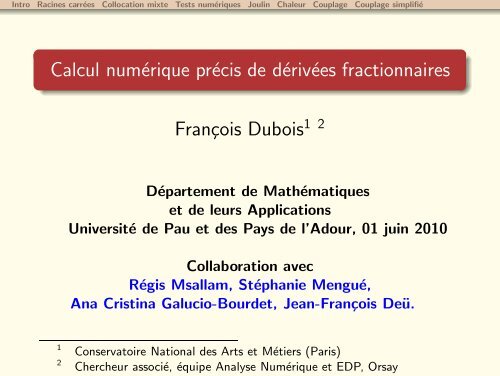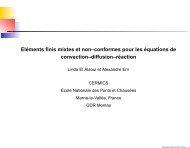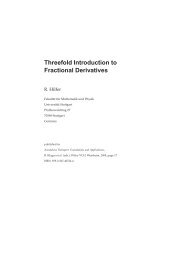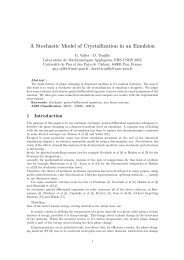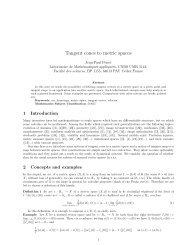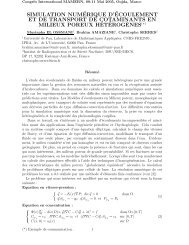f. dubois - Laboratoire de Mathématiques et de leurs Applications ...
f. dubois - Laboratoire de Mathématiques et de leurs Applications ...
f. dubois - Laboratoire de Mathématiques et de leurs Applications ...
Create successful ePaper yourself
Turn your PDF publications into a flip-book with our unique Google optimized e-Paper software.
Intro Racines carrées Collocation mixte Tests numériques Joulin Chaleur Couplage Couplage simplifié<br />
Calcul numérique précis <strong>de</strong> dérivées fractionnaires<br />
1 2<br />
François Dubois<br />
Département <strong>de</strong> <strong>Mathématiques</strong><br />
<strong>et</strong> <strong>de</strong> <strong>leurs</strong> <strong>Applications</strong><br />
Université <strong>de</strong> Pau <strong>et</strong> <strong>de</strong>s Pays <strong>de</strong> l’Adour, 01 juin 2010<br />
Collaboration avec<br />
Régis Msallam, Stéphanie Mengué,<br />
Ana Cristina Galucio-Bour<strong>de</strong>t, Jean-François Deü.<br />
1 Conservatoire National <strong>de</strong>s Arts <strong>et</strong> Métiers (Paris)<br />
2 Chercheur associé, équipe Analyse Numérique <strong>et</strong> EDP, Orsay
Intro Racines carrées Collocation mixte Tests numériques Joulin Chaleur Couplage Couplage simplifié<br />
Plan <strong>de</strong> l’exposé<br />
1) Introduction<br />
2) Racines carrées formelles<br />
3) Collocation mixte<br />
4) Tests numériques<br />
5) Un modèle non linéaire <strong>de</strong> flamme<br />
6) Equation <strong>de</strong> la chaleur <strong>et</strong> intégration d’ordre un-<strong>de</strong>mi<br />
7) Modèle couplé en mécanique <strong>de</strong>s flui<strong>de</strong>s<br />
8) En guise <strong>de</strong> conclusion
Intro Racines carrées Collocation mixte Tests numériques Joulin Chaleur Couplage Couplage simplifié<br />
Dérivée d’ordre un-<strong>de</strong>mi<br />
• Fonction causale u(•), i.e. nulle sur ] − ∞, 0] :<br />
u(t) ≡ 0 si t ≤ 0<br />
• Φ : R × ]0, ∞[ ∋ (v, t) ↦−→ Φ(v, t) ∈ R<br />
fonction assez régulière<br />
• Opérateur <strong>de</strong> “dérivation d’ordre un-<strong>de</strong>mi” :<br />
opérateur <strong>de</strong> convolution défini par<br />
<br />
t<br />
1/2<br />
D u (t) =<br />
0<br />
du ds<br />
.<br />
ds π (t − s)<br />
(1)<br />
(Caputo (1967), voir aussi Lighthill (1978))<br />
• On cherche à approcher numériquement la (?) solution<br />
<strong>de</strong> l’équation semi-différentielle<br />
<br />
D1/2 u (t) = Φ (u (t),t) , t > 0<br />
(2)<br />
u = 0, t ≤ 0.
Intro Racines carrées Collocation mixte Tests numériques Joulin Chaleur Couplage Couplage simplifié<br />
Dérivée d’ordre un-<strong>de</strong>mi (ii)<br />
• Système dynamique<br />
piloté par l’équation semi-différentielle (2).<br />
La connaissance <strong>de</strong> l’ensemble du passé <strong>de</strong> l’instant t<br />
perm<strong>et</strong> <strong>de</strong> connaître le futur.<br />
• Différences finies : pas <strong>de</strong> temps h > 0<br />
t k = k h , u k ≈ u t k , k ∈ N .<br />
• La dérivée d’ordre un <strong>de</strong>mi est la<br />
racine carrée <strong>de</strong> la dérivée usuelle.<br />
Quand on itère <strong>de</strong>ux fois la dérivéee d’ordre un <strong>de</strong>mi,<br />
<br />
D 1/2 D 1/2 <br />
u (t) ≡ du<br />
dt<br />
on trouve la dérivée usuelle.<br />
, t > 0. (3)
Intro Racines carrées Collocation mixte Tests numériques Joulin Chaleur Couplage Couplage simplifié<br />
Extraction <strong>de</strong> racines carrées d’opérateurs<br />
• Fonction causale u(•) approchée par <strong>de</strong>s va<strong>leurs</strong> u k<br />
aux points <strong>de</strong> grille t k<br />
• Schéma aux différences finies décentré amont D u k<br />
précis au premier ordre en espace :<br />
k 1<br />
D u =<br />
h<br />
u k − u k−1 . (4)<br />
• Schéma <strong>de</strong> Gear (1971) D u k à trois points vers le passé,<br />
précis au second ordre en espace :<br />
<br />
. (5)<br />
<br />
k 1 3<br />
D u =<br />
h 2 uk − 2u k−1 + 1<br />
2 uk−2<br />
• Utiliser la relation (3) pour approcher l’expression D 1/2 u(t k )<br />
par un schéma aux différences finies ∆ 1/2 u k <strong>de</strong> la forme :<br />
∆ 1/2 u k ≡ 1<br />
√h<br />
k<br />
j =0<br />
α j u k−j<br />
(6)
Intro Racines carrées Collocation mixte Tests numériques Joulin Chaleur Couplage Couplage simplifié<br />
Extraction <strong>de</strong> racines carrées d’opérateurs (ii)<br />
• Chercher les coefficients <br />
α <strong>de</strong> façon à satisfaire<br />
j j∈N<br />
un analogue discr<strong>et</strong> <strong>de</strong> la relation (3) :<br />
<br />
∆ 1/2 ∆ 1/2 u <br />
(t k ) ≡ Du k , ∀ k ∈ N<br />
avec D l’un <strong>de</strong>s <strong>de</strong>ux opérateurs aux différences D <strong>et</strong> D .<br />
⎧<br />
⎪⎨ D =<br />
⎪⎩<br />
1 <br />
Id − δ<br />
h<br />
D = 1<br />
<br />
3 1<br />
<br />
Id − 2δ + (δ )2 ,<br />
h 2 2<br />
• Les opérateurs discr<strong>et</strong>s<br />
∆ 1/2 u k ≡ 1<br />
√h<br />
k<br />
j =0<br />
α j u k−j , ∆ 1/2<br />
<strong>et</strong> (δ u) k ≡ u k−1 .<br />
u k ≡ 1<br />
√h<br />
k<br />
j =0<br />
α j u k−j<br />
sont égaux aux racines carrées formelles <strong>de</strong>s relations (4) <strong>et</strong> (5).
Intro Racines carrées Collocation mixte Tests numériques Joulin Chaleur Couplage Couplage simplifié<br />
Extraction <strong>de</strong> racines carrées d’opérateurs (iii)<br />
Deux opérateurs discr<strong>et</strong>s pour la dérivée d’ordre un-<strong>de</strong>mi<br />
• Schéma <strong>de</strong> Grünwald (1867) <strong>et</strong> L<strong>et</strong>nikov (1868)<br />
∆ 1/2 = 1<br />
<br />
√ Id − δ<br />
h<br />
• Schéma “G α ” <strong>de</strong> Lubich (1986) <strong>et</strong> Galucio <strong>et</strong> al (2006)<br />
∆ 1/2<br />
<br />
3<br />
<br />
= Id −<br />
2h<br />
4 1<br />
<br />
δ + (δ )2<br />
3 3<br />
<br />
1<br />
∞<br />
n 1 3<br />
G 2 ≡<br />
gj+1 u<br />
∆t 2<br />
n−j<br />
• La dérivée d’ordre fractionnaire<br />
est un opérateur <strong>de</strong> convolution<br />
j=0<br />
(7)<br />
(8)
Intro Racines carrées Collocation mixte Tests numériques Joulin Chaleur Couplage Couplage simplifié<br />
Extraction <strong>de</strong> racines carrées d’opérateurs (iv)<br />
• Calcul <strong>de</strong>s coefficients avec un logiciel <strong>de</strong> calcul formel<br />
j gj<br />
0 1<br />
1 −2/3<br />
2 −1/18<br />
3 −1/27<br />
4 −17/648<br />
5 −19/972<br />
6 −59/3888<br />
7 −71/5832<br />
8 −2807/279936<br />
9 −10627/1259712<br />
10 −109159/15116544
Intro Racines carrées Collocation mixte Tests numériques Joulin Chaleur Couplage Couplage simplifié<br />
Extraction <strong>de</strong> racines carrées d’opérateurs (v)<br />
• Algorithme <strong>de</strong> résolution<br />
Le calcul numérique <strong>de</strong> l’étape numéro j<br />
<strong>de</strong>man<strong>de</strong> <strong>de</strong> résoudre une équation d’inconnue u j <strong>de</strong> la forme<br />
• Schémas implicites.<br />
α 0 u j − Φ(u j , j ∆t) = ρ j<br />
où ρ j est une fonction donnée<br />
<strong>de</strong>s variables u 0 = 0, u 1 , · · · , u j−1 .
Intro Racines carrées Collocation mixte Tests numériques Joulin Chaleur Couplage Couplage simplifié<br />
On reprend le problème autrement<br />
• The l<strong>et</strong>ter β, 0 < β < 1, is a real number,<br />
Γ(•) is the classical Euler function.<br />
• Fractional differential operator Dβ (•) :<br />
(D β t 1 du dθ<br />
u)(t) ≡<br />
. (9)<br />
Γ(1 − β) 0 dθ 1−β<br />
(t − θ)<br />
• Fractional ordinary differential equation of or<strong>de</strong>r β :<br />
D β (u − u0) = Φ (u (t),t) , t > 0<br />
u − u0 = 0, t ≤ 0.<br />
(10)
Intro Racines carrées Collocation mixte Tests numériques Joulin Chaleur Couplage Couplage simplifié<br />
Discrétisation<br />
• Discr<strong>et</strong>ization step h > 0.<br />
• Discr<strong>et</strong>e space P h 1 :<br />
continuous functions that are<br />
affine in each mesh element ]jh, (j + 1)h[.<br />
• Discr<strong>et</strong>e space Q h 0<br />
: constant functions in each element.<br />
• Fractional integrator I β of or<strong>de</strong>r β :<br />
I β (v (•),t) ≡ 1<br />
t<br />
(t − θ)<br />
Γ(β)<br />
β−1 v (θ) dθ . (11)<br />
0
Intro Racines carrées Collocation mixte Tests numériques Joulin Chaleur Couplage Couplage simplifié<br />
Collocation mixte<br />
• Integrate the equation (10)<br />
with the fractional integrator I β (11) :<br />
u (t) − u0 = I β (Φ (u (•) , t)), t ≥ 0. (12)<br />
• Low or<strong>de</strong>r (P1Q0) mixed collocation m<strong>et</strong>hod : choose<br />
a discr<strong>et</strong>e state u h (•) satisfying u h ∈ P h 1<br />
a flux f h ≃ Φ (u (•) ,t) according to the condition f h ∈ Q h 0 .<br />
• Write the equation (12) at the grid points jh (j ∈ N) :<br />
<br />
, j ∈ N . (13)<br />
u h <br />
β<br />
(jh) − u0 = I f h (•) , jh
Intro Racines carrées Collocation mixte Tests numériques Joulin Chaleur Couplage Couplage simplifié<br />
Collocation mixte (ii)<br />
• Mean value of the approached flux f h (•) :<br />
equal to the mean value of the exact flux in each element :<br />
(j+1)h<br />
f h (θ) dθ ≡<br />
(j+1)h <br />
Φ u h <br />
(θ),θ dθ . (14)<br />
jh<br />
• ”Projection step” on the discr<strong>et</strong>e space Q h 0 :<br />
f h<br />
j+ 1<br />
2<br />
=<br />
1<br />
0<br />
jh<br />
<br />
Φ u h j (1 − θ) + θuh <br />
j+1 , jh + θh dθ , j ∈ N . (15)
Intro Racines carrées Collocation mixte Tests numériques Joulin Chaleur Couplage Couplage simplifié<br />
Collocation mixte (iii)<br />
• ”State-flux constraint” for the scheme P1Q0 :<br />
the relations (13)(15) take the form<br />
u h j+1 −<br />
hβ h<br />
f<br />
Γ(β + 1) j+ 1<br />
2<br />
= u0 +<br />
hβ j−1<br />
αj−k f<br />
Γ(β + 1)<br />
k=0<br />
h<br />
k+ 1 , (16)<br />
2<br />
with j ∈ N , αk ≡ (k + 1) β − k β , k ∈ N .<br />
• Newton m<strong>et</strong>hod for the numerical solution of eqs. (15) (16) ;<br />
”Semidif” software,<br />
see http : //www.laas.fr/gt-opd/ (free of charge !).
Intro Racines carrées Collocation mixte Tests numériques Joulin Chaleur Couplage Couplage simplifié<br />
Premiers tests numériques<br />
• Elementary tests with β = 0.5 and<br />
Dynamics Φ (u ,t) ≡ g (t) with g(•) chosen as :<br />
<br />
g1 (t) = 1 √<br />
2 π , g2 (t) = 2 √<br />
√ t , g3 (t) =<br />
π<br />
3 √<br />
4 π t ,<br />
g4 (t) = 8<br />
3 √ π t √ t , g5 (t) = 15 √<br />
16 π t2 .<br />
(17)<br />
• Then the solution of equation (10) is simply<br />
√tj uj(t) ≡ , j = 1, · · · ,5. (18)<br />
as shown on the following figures.
Intro Racines carrées Collocation mixte Tests numériques Joulin Chaleur Couplage Couplage simplifié<br />
Premiers tests numériques (ii)<br />
1.2<br />
1<br />
0.8<br />
0.6<br />
0.4<br />
0.2<br />
Solution exacte u 1 (t) = t 1/2<br />
Schéma <strong>de</strong> GL à <strong>de</strong>ux points<br />
Schéma <strong>de</strong> GL à trois points<br />
Schéma <strong>de</strong> Msallam<br />
Schéma par éléments finis<br />
Schéma mixte P 1 Q 0<br />
Schéma mixte P 1 Q 1<br />
D 1/2 u 1 = π 1/2 /2<br />
Solutions exacte <strong>et</strong> approchées avec 8 points<br />
0<br />
0 0.2 0.4 0.6 0.8 1<br />
Numerical solution of D 1/2 u = g1 (t) ; u(t) = √ t.
Intro Racines carrées Collocation mixte Tests numériques Joulin Chaleur Couplage Couplage simplifié<br />
Premiers tests numériques (iii)<br />
1.2<br />
1<br />
0.8<br />
0.6<br />
0.4<br />
0.2<br />
Solution exacte u 2 (t)= t<br />
Schéma <strong>de</strong> GL à <strong>de</strong>ux points<br />
Schéma <strong>de</strong> GL à trois points<br />
Schéma <strong>de</strong> Msallam<br />
Schéma par éléments finis<br />
Schéma mixte P 1 Q 0<br />
Schéma mixte P 1 Q 1<br />
D 1/2 u 2 = 2(t/π) 1/2<br />
Solutions exacte <strong>et</strong><br />
approchées avec 8 points<br />
0<br />
0 0.2 0.4 0.6 0.8 1<br />
Numerical solution of D 1/2 u = g2 (t) ; u(t) = t.
Intro Racines carrées Collocation mixte Tests numériques Joulin Chaleur Couplage Couplage simplifié<br />
Premiers tests numériques (iv)<br />
1.2<br />
1<br />
0.8<br />
0.6<br />
0.4<br />
0.2<br />
Solution exacte u 3 (t)= t 3/2<br />
Schéma <strong>de</strong> GL à <strong>de</strong>ux points<br />
Schéma <strong>de</strong> GL à trois points<br />
Schéma <strong>de</strong> Msallam<br />
Schéma par éléments finis<br />
Schéma mixte P 1 Q 0<br />
Schéma mixte P 1 Q 1<br />
D 1/2 u 3 = 3 π 1/2 t / 4<br />
Solutions exacte <strong>et</strong><br />
approchées avec 8 points<br />
0<br />
0 0.2 0.4 0.6 0.8 1<br />
Numerical solution of D 1/2 u = g3 (t) ; u(t) = t √ t.
Intro Racines carrées Collocation mixte Tests numériques Joulin Chaleur Couplage Couplage simplifié<br />
Premiers tests numériques (v)<br />
1.2<br />
1<br />
0.8<br />
0.6<br />
0.4<br />
0.2<br />
Solution exacte u 4 (t)= t 2<br />
Schéma <strong>de</strong> GL à <strong>de</strong>ux points<br />
Schéma <strong>de</strong> GL à trois points<br />
Schéma <strong>de</strong> Msallam<br />
Schéma par éléments finis<br />
Schéma mixte P 1 Q 0<br />
Schéma mixte P 1 Q 1<br />
Solutions exacte <strong>et</strong><br />
approchées avec 8 points<br />
D 1/2 u 4 = 8 t 3/2 / 3π 1/2<br />
0<br />
0 0.2 0.4 0.6 0.8 1<br />
Numerical solution of D 1/2 u = g4 (t) ; u(t) = t 2 .
Intro Racines carrées Collocation mixte Tests numériques Joulin Chaleur Couplage Couplage simplifié<br />
Premiers tests numériques (vi)<br />
1.2<br />
1<br />
0.8<br />
0.6<br />
0.4<br />
0.2<br />
Solution exacte u 5 (t)= t 5/2<br />
Schéma <strong>de</strong> GL à <strong>de</strong>ux points<br />
Schéma <strong>de</strong> GL à trois points<br />
Schéma <strong>de</strong> Msallam<br />
Schéma par éléments finis<br />
Schéma mixte P 1 Q 0<br />
Schéma mixte P 1 Q 1<br />
Solutions exacte <strong>et</strong><br />
approchées avec 8 points<br />
D 1/2 u 5 = 15 π 1/2 t 2 / 16<br />
0<br />
0 0.2 0.4 0.6 0.8 1<br />
Numerical solution of D 1/2 u = g5 (t) ; u(t) = t 2 √ t.
Intro Racines carrées Collocation mixte Tests numériques Joulin Chaleur Couplage Couplage simplifié<br />
Premiers tests numériques (vii)<br />
• Or<strong>de</strong>rs of convergente with mesh steps h,<br />
h = 1<br />
2 n , 3 ≤ n ≤ 13.<br />
• Errors e n 2 relatively to the norm L2 and e n ∞ for the norm L∞ :<br />
e n 2 ≡ √ h<br />
<br />
<br />
2<br />
|u (0) − u0|<br />
+<br />
2<br />
2n −1<br />
j=1<br />
<br />
<br />
<br />
u <br />
j<br />
2n <br />
2<br />
− uj<br />
<br />
+ |u (1) − u2n| 2<br />
.<br />
2<br />
(19)<br />
e n ∞ ≡ max{|u(jh) − uj |, j = 0, · · · ,2 n } (20)
Intro Racines carrées Collocation mixte Tests numériques Joulin Chaleur Couplage Couplage simplifié<br />
Premiers tests numériques (viii)<br />
• Or<strong>de</strong>rs of convergence for the previous test case :<br />
• Satisfying results ?<br />
Mixed scheme P1Q0<br />
L ∞ L 2<br />
g1 (t) ∞ ∞<br />
g2 (t) 1.0000 1.3982<br />
g3 (t) 1.4850 1.4677<br />
g4 (t) 1.4722 1.4627<br />
g5 (t) 1.4613 1.4564
Intro Racines carrées Collocation mixte Tests numériques Joulin Chaleur Couplage Couplage simplifié<br />
Premiers tests numériques (ix)<br />
• Tests with β = 0.5<br />
and nonlinear dynamics Φ (u ,t) ≡ f (u) :<br />
<br />
f1 (u) = 1 √<br />
2 π , f2 (u) = 2 √<br />
π<br />
f4 (u) = 8<br />
3 √ π<br />
u 3<br />
4 , f5 (t) = 15<br />
16<br />
√ u , f3 (u) = 3<br />
√ π u 4<br />
5 .<br />
4<br />
√ π u 2<br />
3 ,<br />
(21)<br />
• Then the solution of equation (10) is simply<br />
√tj uj(t) ≡ , j = 1, · · · ,5. (22)<br />
as in the five previous test cases.
Intro Racines carrées Collocation mixte Tests numériques Joulin Chaleur Couplage Couplage simplifié<br />
Premiers tests numériques (x)<br />
1.2<br />
1<br />
0.8<br />
0.6<br />
0.4<br />
0.2<br />
Solution exacte u 1 (t) = t 1/2<br />
Schéma <strong>de</strong> GL à <strong>de</strong>ux points<br />
Schéma <strong>de</strong> GL à trois points<br />
Schéma <strong>de</strong> Msallam<br />
Schéma par éléments finis<br />
Schéma mixte P 1 Q 0<br />
Schéma mixte P 1 Q 1<br />
D 1/2 u 1 = π 1/2 /2<br />
Solutions exacte <strong>et</strong> approchées avec 8 points<br />
0<br />
0 0.2 0.4 0.6 0.8 1<br />
Numerical solution of D 1/2 u = f1 (u) ; u(t) = √ t.
Intro Racines carrées Collocation mixte Tests numériques Joulin Chaleur Couplage Couplage simplifié<br />
Premiers tests numériques (xi)<br />
1.2<br />
1<br />
0.8<br />
0.6<br />
0.4<br />
0.2<br />
Solution exacte u 2 (t)= t<br />
Schéma <strong>de</strong> GL à <strong>de</strong>ux points<br />
Schéma <strong>de</strong> GL à trois points<br />
Schéma <strong>de</strong> Msallam<br />
Schéma par éléments finis<br />
Schéma mixte P 1 Q 0<br />
Schéma mixte P 1 Q 1<br />
D 1/2 u 2 = 2(u 2 /π) 1/2<br />
Solutions exacte <strong>et</strong><br />
approchées avec 8 points<br />
0<br />
0 0.2 0.4 0.6 0.8 1<br />
Numerical solution of D 1/2 u = f2 (u) ; u(t) = t.
Intro Racines carrées Collocation mixte Tests numériques Joulin Chaleur Couplage Couplage simplifié<br />
Premiers tests numériques (xii)<br />
1.4<br />
1.2<br />
1<br />
0.8<br />
0.6<br />
0.4<br />
0.2<br />
Solution exacte u 3 (t)= t 3/2<br />
Schéma <strong>de</strong> GL à <strong>de</strong>ux points<br />
Schéma <strong>de</strong> GL à trois points<br />
Schéma <strong>de</strong> Msallam<br />
Schéma par éléments finis<br />
Schéma mixte P 1 Q 0<br />
Schéma mixte P 1 Q 1<br />
D 1/2 u 3 = 3 π 1/2 u 3 2/3 / 4<br />
Solutions exacte <strong>et</strong><br />
approchées avec 8 points<br />
0<br />
0 0.2 0.4 0.6 0.8 1<br />
Numerical solution of D 1/2 u = f3 (u) ; u(t) = t √ t.
Intro Racines carrées Collocation mixte Tests numériques Joulin Chaleur Couplage Couplage simplifié<br />
Premiers tests numériques (xiii)<br />
1.8<br />
1.6<br />
1.4<br />
1.2<br />
1<br />
0.8<br />
0.6<br />
0.4<br />
0.2<br />
Solution exacte u 4 (t)= t 2<br />
Schéma <strong>de</strong> GL à <strong>de</strong>ux points<br />
Schéma <strong>de</strong> GL à trois points<br />
Schéma <strong>de</strong> Msallam<br />
Schéma par éléments finis<br />
Schéma mixte P 1 Q 0<br />
Schéma mixte P 1 Q 1<br />
Solutions exacte <strong>et</strong><br />
approchées avec 8 points<br />
D 1/2 u 4 = 8 u 4 3/4 /3π 1/2<br />
0<br />
0 0.2 0.4 0.6 0.8 1<br />
Numerical solution of D 1/2 u = f4 (u) ; u(t) = t 2 .
Intro Racines carrées Collocation mixte Tests numériques Joulin Chaleur Couplage Couplage simplifié<br />
Premiers tests numériques (xiv)<br />
2.5<br />
2<br />
1.5<br />
1<br />
0.5<br />
Solution exacte u 5 (t)= t 5/2<br />
Schéma <strong>de</strong> GL à <strong>de</strong>ux points<br />
Schéma <strong>de</strong> GL à trois points<br />
Schéma <strong>de</strong> Msallam<br />
Schéma par éléments finis<br />
Schéma mixte P 1 Q 0<br />
Schéma mixte P 1 Q 1<br />
D 1/2 u 5 = 15 π 1/2 u 5 4/5 / 16<br />
Solutions exacte <strong>et</strong><br />
approchées avec 8 points<br />
0<br />
0 0.2 0.4 0.6 0.8 1<br />
Numerical solution of D 1/2 u = f5 (u) ; u(t) = t 2 √ t.
Intro Racines carrées Collocation mixte Tests numériques Joulin Chaleur Couplage Couplage simplifié<br />
Premiers tests numériques (xv)<br />
• Or<strong>de</strong>rs of convergente with mesh steps h = 1<br />
2 n , 3 ≤ n ≤ 13.<br />
• Errors e n 2 relatively to the norm L2 and e n ∞ for the norm L∞ :<br />
the mixed collocation scheme is convergent,<br />
the or<strong>de</strong>r of accuracy is equal to 1.<br />
• Satisfying scheme ?
Intro Racines carrées Collocation mixte Tests numériques Joulin Chaleur Couplage Couplage simplifié<br />
Premiers tests numériques (xvi)<br />
• Comparison with published results :<br />
previous numerical algorithms proposed by<br />
Lubich (1986), Blank (1996), Di<strong>et</strong>helm (1997),<br />
Di<strong>et</strong>helm and Ford (1999), Di<strong>et</strong>helm and Luchko (2000).<br />
• Example of test case proposed by L. Blank (1996) :<br />
D 1/2 u + u = 0, t > 0<br />
u = 1, t ≤ 0.<br />
• Analytical solution : u (t) = e t 1 − erf √ t .<br />
A particular case of the Mittag-Leffler exponential :<br />
Eα(θ) =<br />
∞<br />
k=0<br />
(23)<br />
θk . (24)<br />
Γ(1 + α k)
Intro Racines carrées Collocation mixte Tests numériques Joulin Chaleur Couplage Couplage simplifié<br />
Premiers tests numériques (xvii)<br />
1<br />
0.9<br />
0.8<br />
0.7<br />
0.6<br />
0.5<br />
D 1/2 (u) = −u , u(0) = 1<br />
Solution exacte u(t)= e t (1−erf(t 0.5 ))<br />
Schéma mixte P 1 Q 0<br />
Schéma mixte P 1 Q 1<br />
Solutions exacte <strong>et</strong> approchées<br />
avec 8 points<br />
0.4<br />
0 0.2 0.4 0.6 0.8 1<br />
Numerical solution of equation (23).
Intro Racines carrées Collocation mixte Tests numériques Joulin Chaleur Couplage Couplage simplifié<br />
Modèle non linéaire avec une singularité<br />
• Spherical flames semi-differential equation (Joulin [1985]) :<br />
<br />
1/2<br />
D (u) = Φ (u (t),t) , t > 0<br />
(25)<br />
u = 0, t ≤ 0<br />
Φ (u (t),t) = log u + E tγ (1 − t)<br />
u<br />
H(1 − t) , (26)<br />
• where E and γ = 0.3 are positive constants<br />
and θ ↦−→ H(θ) is the Heavisi<strong>de</strong> function.<br />
• Note the singularity at t = 0 !
Intro Racines carrées Collocation mixte Tests numériques Joulin Chaleur Couplage Couplage simplifié<br />
Modèle non linéaire avec une singularité (ii)<br />
• Delicate computation of the first point u h 1 .<br />
• After elementary algebra, we see that the value uh 1 is solution<br />
of the following equation of unknown x :<br />
<br />
<br />
h E hγ 1 h<br />
x = 2 log x − 1 + − . (27)<br />
π<br />
x γ γ + 1<br />
• Numerical resolution with the Newton algorithm.<br />
• Reference : Audoun<strong>et</strong> and Roquejoffre (1998)<br />
with diffusive representation.
Intro Racines carrées Collocation mixte Tests numériques Joulin Chaleur Couplage Couplage simplifié<br />
Modèle non linéaire avec une singularité (iii)<br />
• Delicate computation of the general point u h j .<br />
Approximation of the flux by the m<strong>et</strong>hod of trapezes :<br />
u h j+1 −<br />
⎧<br />
⎪⎨<br />
⎪⎩<br />
f h<br />
j+ 1<br />
2<br />
+ E hγ−1<br />
√<br />
h h<br />
f<br />
Γ(3/2) j+ 1<br />
2<br />
≃<br />
2<br />
=<br />
√<br />
h j−1<br />
Γ(3/2)<br />
k=0<br />
<br />
j − k + 1 − j − k f h<br />
k+ 1<br />
2<br />
1<br />
uh j+1 − uh <br />
u<br />
j<br />
h j+1 log uh j+1 − uh <br />
j+1 − 1<br />
<br />
jγ−1 (1 − jh)<br />
uh +<br />
j<br />
(j + 1)γ−1 (1 − (j + 1) h)<br />
uh j+1<br />
<br />
.
Intro Racines carrées Collocation mixte Tests numériques Joulin Chaleur Couplage Couplage simplifié<br />
Modèle non linéaire avec une singularité (iv)<br />
18<br />
16<br />
14<br />
12<br />
10<br />
8<br />
6<br />
4<br />
2<br />
50 points<br />
100 points<br />
500 points<br />
1000 points<br />
10000 points<br />
100000 points<br />
E=7.7 <strong>et</strong> t max =40<br />
0<br />
0 5 10 15 20 25 30 35 40<br />
Numerical solution of equation (25)(26) for E = 7.7 .
Intro Racines carrées Collocation mixte Tests numériques Joulin Chaleur Couplage Couplage simplifié<br />
Modèle non linéaire avec une singularité (v)<br />
18<br />
16<br />
14<br />
12<br />
10<br />
8<br />
6<br />
4<br />
2<br />
50 points<br />
100 points<br />
500 points<br />
1000 points<br />
10000 points<br />
100000 points<br />
E=7.8 <strong>et</strong> t max =40<br />
0<br />
0 5 10 15 20 25 30 35 40<br />
Numerical solution of equation (25)(26) for E = 7.8 .
Intro Racines carrées Collocation mixte Tests numériques Joulin Chaleur Couplage Couplage simplifié<br />
Modèle non linéaire avec une singularité (vi)<br />
12<br />
10<br />
8<br />
6<br />
4<br />
2<br />
5000 points<br />
4000 points<br />
3940 points<br />
3931 points<br />
3930 points<br />
3900 points<br />
3800 points<br />
3000 points<br />
500 points<br />
Simulations avec E=7.6<br />
<strong>et</strong> t max =40<br />
Changement <strong>de</strong> comportement<br />
entre np=3930 <strong>et</strong> np=3931<br />
points <strong>de</strong> calcul<br />
0<br />
0 5 10 15 20 25 30<br />
Changing the type of comportment for E = 7.6 .
Intro Racines carrées Collocation mixte Tests numériques Joulin Chaleur Couplage Couplage simplifié<br />
Modèle non linéaire avec une singularité (vii)<br />
2.5<br />
2<br />
1.5<br />
1<br />
0.5<br />
E=7.6<br />
1000 points<br />
2500 points<br />
5000 points<br />
10000 points<br />
25000 points<br />
50000 points<br />
0<br />
0 1 2 3 4 5 6 7 8 9 10<br />
Numerical solution of equation (25)(26) for E = 7.6 .
Intro Racines carrées Collocation mixte Tests numériques Joulin Chaleur Couplage Couplage simplifié<br />
Modèle non linéaire avec une singularité (viii)<br />
4.5<br />
4<br />
3.5<br />
3<br />
2.5<br />
2<br />
1.5<br />
1<br />
0.5<br />
1000 points<br />
2500 points<br />
5000 points<br />
10000 points<br />
25000 points<br />
50000 points<br />
100000 points<br />
250000 points<br />
E=7.66<br />
0<br />
0 1 2 3 4 5 6 7 8 9 10 11 12 13 14 15 16<br />
Numerical solution of equation (25)(26) for E = 7.66 .
Intro Racines carrées Collocation mixte Tests numériques Joulin Chaleur Couplage Couplage simplifié<br />
Modèle non linéaire avec une singularité (ix)<br />
4.5<br />
4<br />
3.5<br />
3<br />
2.5<br />
2<br />
1.5<br />
1<br />
0.5<br />
1000 points<br />
2500 points<br />
5000 points<br />
10000 points<br />
25000 points<br />
50000 points<br />
100000 points<br />
E=7.67<br />
0<br />
0 1 2 3 4 5 6 7 8 9 10 11 12 13 14 15 16<br />
Numerical solution of equation (25)(26) for E = 7.67 .
Intro Racines carrées Collocation mixte Tests numériques Joulin Chaleur Couplage Couplage simplifié<br />
Modèle non linéaire avec une singularité (x)<br />
4.5<br />
4<br />
3.5<br />
3<br />
2.5<br />
2<br />
1.5<br />
1<br />
0.5<br />
1000 points<br />
2500 points<br />
5000 points<br />
10000 points<br />
25000 points<br />
50000 points<br />
100000 points<br />
250000 points<br />
500000 points<br />
1000000 points<br />
2500000 points<br />
E=7.665<br />
0<br />
0 1 2 3 4 5 6 7 8 9 10 11 12 13 14 15 16<br />
Numerical solution of equation (25)(26) for E = 7.665 .
Intro Racines carrées Collocation mixte Tests numériques Joulin Chaleur Couplage Couplage simplifié<br />
Modèle non linéaire avec une singularité (xi)<br />
Donc 7.665 < E < 7.67 ; γ = 0.3.<br />
pas tout à fait comme nos auteurs en référence !<br />
3.5<br />
3<br />
2.5<br />
2<br />
1.5<br />
1<br />
0.5<br />
zoom <strong>de</strong> la courbe <strong>de</strong> 10000 points<br />
asymptote calculée<br />
E=7.7 <strong>et</strong> t max =10<br />
On voit que le premier point<br />
est bien calculé<br />
0<br />
0 0.2 0.4 0.6 0.8 1<br />
Le premier point est calculé <strong>de</strong> façon précise
Intro Racines carrées Collocation mixte Tests numériques Joulin Chaleur Couplage Couplage simplifié<br />
Equations aux dérivées partielles<br />
• Problème <strong>de</strong> thermique<br />
y ∈ [0, +∞[<br />
Diffusivité µ > 0<br />
Fonction du temps f (t) t ≥ 0<br />
• On cherche une fonction u(y, t)<br />
solution <strong>de</strong> l’équation <strong>de</strong> la chaleur<br />
∂u<br />
∂t − µ ∂2u = f (t), t > 0, y ≥ 0. (28)<br />
∂y 2<br />
Condition limite en y = 0 :<br />
u(0, t) = 0<br />
Condition limite pour y tendant vers +∞ :<br />
∂u<br />
(y, t) −→ 0 si y −→ +∞.<br />
∂y
Intro Racines carrées Collocation mixte Tests numériques Joulin Chaleur Couplage Couplage simplifié<br />
Equations aux dérivées partielles (ii)<br />
temperature<br />
1<br />
0<br />
0<br />
abscisse<br />
Profil typique <strong>de</strong> couche limite thermique.<br />
Flux <strong>de</strong> chaleur Φ(t) à la paroi donné par la loi <strong>de</strong> Fourier :<br />
Φ(t) = −µ ∂u<br />
(0, t), t > 0<br />
∂y<br />
représenté graphiquement par la tangente en y = 0<br />
à la courbe <strong>de</strong> la figure ci-<strong>de</strong>ssus.<br />
1
Intro Racines carrées Collocation mixte Tests numériques Joulin Chaleur Couplage Couplage simplifié<br />
Equations aux dérivées partielles (iii)<br />
• Résolution analytique<br />
à l’ai<strong>de</strong> <strong>de</strong> la transformation <strong>de</strong> Fourier en temps.<br />
u(y,ω) <strong>de</strong> la fonction u :<br />
+∞<br />
u(y, t) = 1<br />
u(y,ω) exp (i ω t) dω<br />
2π −∞<br />
On dérive par rapport au temps :<br />
∂u<br />
∂t<br />
= 1<br />
2π<br />
+∞<br />
−∞<br />
i ω u(y,ω) exp(i ω t) dω .<br />
ce qui constitue une proposition bien classique : ∂u<br />
= iω u .<br />
∂t<br />
On note f la fransformée <strong>de</strong> Fourier du second membre f .<br />
Alors l’équation <strong>de</strong> la chaleur s’écrit simplement :<br />
iωu − µ ∂2 u<br />
∂y 2 = f . (29)
Intro Racines carrées Collocation mixte Tests numériques Joulin Chaleur Couplage Couplage simplifié<br />
Equations aux dérivées partielles (iv)<br />
• Racine carrée complexe :<br />
On note √ z la détermination principale <strong>de</strong> √ z.<br />
√ <br />
r exp(i θ) ≡ r exp i θ<br />
<br />
, r > 0, −π < θ < π .<br />
2<br />
On a donc en particulier :<br />
Re √ z > 0, z ∈ ] − ∞, 0].<br />
On peut alors résoudre l’équation (29) :<br />
u(y, ω) = 1<br />
iω <br />
f + α exp<br />
<br />
iω<br />
µ y<br />
<br />
+ β exp −<br />
<br />
iω<br />
µ y<br />
<br />
.<br />
Pas <strong>de</strong> solution exponentiellement croissante en y<br />
à cause <strong>de</strong> la condition limite en +∞.<br />
Donc nécessairement α = 0.
Intro Racines carrées Collocation mixte Tests numériques Joulin Chaleur Couplage Couplage simplifié<br />
Equations aux dérivées partielles (v)<br />
• Prise en compte <strong>de</strong> la condition limite en y = 0. On a<br />
u(y, ω) = 1<br />
iω f<br />
<br />
1 − exp −<br />
On dérive c<strong>et</strong>te expression par rapport à y :<br />
∂u 1<br />
<br />
(y, ω) = √ f exp −<br />
∂y iµω<br />
<br />
iω<br />
µ y<br />
.<br />
<br />
iω<br />
µ y<br />
<br />
Puis on fait y = 0 :<br />
<br />
Φ(ω)<br />
µ<br />
= −<br />
iω f .<br />
<br />
1<br />
La quantité iω f (ω) s’interprète comme la<br />
transformée <strong>de</strong> Fourier d’une intégrale d’ordre un-<strong>de</strong>mi
Intro Racines carrées Collocation mixte Tests numériques Joulin Chaleur Couplage Couplage simplifié<br />
Equations aux dérivées partielles (vi)<br />
• Nous posons<br />
ρ(t) ≡ 1 √ t Y (t),<br />
avec Y (t) fonction <strong>de</strong> Heavisi<strong>de</strong> définie par<br />
<br />
0 si t < 0<br />
Y (t) =<br />
1 si t > 0,<br />
Nous avons :<br />
• Flux <strong>de</strong> chaleur :<br />
ρ =<br />
π<br />
i ω .<br />
Φ = −<br />
µ<br />
π ρ f . (30)
Intro Racines carrées Collocation mixte Tests numériques Joulin Chaleur Couplage Couplage simplifié<br />
Equations aux dérivées partielles (vii)<br />
• Convolution ρ ∗ f <strong>de</strong>s fonctions ρ <strong>et</strong> f , définie par<br />
<br />
∞<br />
ρ ∗ f (x) ≡ ρ(y)f (x − y)dy ,<br />
Avec la relation classique<br />
on a finalement<br />
<br />
Φ(t)<br />
µ<br />
= −<br />
π<br />
−∞<br />
<br />
ρ ∗ f = ρ f ,<br />
<br />
µ<br />
ρ ∗ f = −<br />
π<br />
0<br />
t dθ<br />
f (θ) √ .<br />
t − θ<br />
• Intégrateur d’ordre un-<strong>de</strong>mi d’une fonction causale<br />
On appelle intégrateur d’ordre un-<strong>de</strong>mi<br />
<strong>et</strong> on note I1/2u (t) la fonction causale définie par<br />
1/2<br />
I u (t) ≡<br />
<br />
1 t dθ<br />
√π u(θ) √<br />
t − θ<br />
si t > 0. (31)<br />
0
Intro Racines carrées Collocation mixte Tests numériques Joulin Chaleur Couplage Couplage simplifié<br />
Thin Layer Navier Stokes equations : hypotheses<br />
• Geom<strong>et</strong>ry : the ratio h<br />
L<br />
is small :<br />
• Length scale Λ = wave length λ<br />
• Propagation of longitudinal mo<strong>de</strong> :<br />
h<br />
L<br />
h 1<br />
<<br />
λ 4<br />
• Characteristic length for diffusion : l = µ<br />
• Acoustic Reynolds number : R acou<br />
e<br />
• Small param<strong>et</strong>er ǫ ≡ l<br />
Λ ≈<br />
1<br />
R acou<br />
e<br />
Intro Racines carrées Collocation mixte Tests numériques Joulin Chaleur Couplage Couplage simplifié<br />
Thin Layer Navier Stokes equations : notations<br />
2h<br />
Λ<br />
l<br />
L<br />
Channel with characteristic lenghts.
Intro Racines carrées Collocation mixte Tests numériques Joulin Chaleur Couplage Couplage simplifié<br />
Thin Layer Navier Stokes equations : algèbre<br />
∂ ρ<br />
∂ t<br />
∂ ∂<br />
+ (ρu) + (ρv) = 0<br />
∂ x ∂ y<br />
∂ ∂ 2 ∂ ∂<br />
(ρu) + ρu + p + ρu v = µ<br />
∂ t ∂ x<br />
∂ y<br />
2 u<br />
∂ y2 ∂ ∂ ∂ 2<br />
(ρv) + ρu v + ρv + p =<br />
∂ t ∂ x ∂ y<br />
µ ∂<br />
<br />
1 ∂ u 4 ∂ v<br />
<br />
+<br />
∂ y 3 ∂ x 3 ∂ y<br />
<br />
∂<br />
<br />
ρ e +<br />
∂ t<br />
1<br />
2 u2 + ∂<br />
<br />
ρu e +<br />
∂ x<br />
1<br />
2 u2<br />
<br />
+ p u +<br />
+ ∂<br />
<br />
ρv e +<br />
∂ y<br />
1<br />
2 u2<br />
<br />
+ p v = µ ∂<br />
<br />
∂ u<br />
<br />
u + k<br />
∂ y ∂ y<br />
∂2 T<br />
∂ y2 p = (γ − 1)ρe .
Intro Racines carrées Collocation mixte Tests numériques Joulin Chaleur Couplage Couplage simplifié<br />
Flui<strong>de</strong> parfait pour l’écoulement moyen : hypothèses<br />
• Integrate TLNS equations b<strong>et</strong>ween y = −h and y = +h<br />
Introduce mean values : ρ(t,x) = 1<br />
h<br />
2h −h ρ(t,x,y)dy<br />
ρ(t,x) u(t,x) = 1<br />
h<br />
2h −h (ρu)(t,x,y)dy<br />
ρ(t,x)e(t,x) + 1<br />
2 ρ(t,x) u2 (t,x) ≡<br />
<br />
1 h 1<br />
ρe +<br />
2h −h 2 ρu2 (t,x,y)dy<br />
• Assume that the boundary layer thickness δ is small :<br />
shear number Sh ≡ δ<br />
Intro Racines carrées Collocation mixte Tests numériques Joulin Chaleur Couplage Couplage simplifié<br />
Flui<strong>de</strong> parfait pour l’écoulement moyen : algèbre<br />
p ≡ (γ − 1) ρe<br />
∂ ρ<br />
∂t<br />
∂ <br />
+ ρu = 0.<br />
∂x<br />
∂ ∂<br />
ρu +<br />
∂ t ∂ x<br />
<br />
ρu 2 <br />
+ p<br />
∂ 1<br />
ρe +<br />
∂ t 2 ρ u2 + ∂<br />
<br />
∂ x<br />
= k<br />
2h<br />
µ<br />
2h<br />
=<br />
<br />
∂u ∂u<br />
(t,x,h) − (t,x, −h)<br />
∂y ∂y<br />
ρ u e + 1<br />
∂T<br />
∂y<br />
2 u2 <br />
+ p u<br />
(t,x,h) − ∂T<br />
∂y<br />
=<br />
<br />
(t,x, −h) .<br />
Observe that skin friction and heat flux<br />
are sources for main perfect flow !
Intro Racines carrées Collocation mixte Tests numériques Joulin Chaleur Couplage Couplage simplifié<br />
Couche limite acoustique<br />
• Linearize the TLNS equations<br />
around the reference state (ρ0, p0, θ0) :<br />
•<br />
•<br />
p ′<br />
p0<br />
• ρ0<br />
• ρ0 Cp<br />
= ρ′<br />
ρ0<br />
+ T ′<br />
θ0<br />
∂ρ ′<br />
∂t + ρ0 div u ′ = 0<br />
∂u ′<br />
∂t − µ ∂2u ′ ∂p′<br />
= −<br />
∂y 2 ∂x<br />
∂T ′<br />
∂t − k ∂2T ′ ∂p′<br />
=<br />
∂y 2 ∂t .<br />
• Boundary conditions at the bottom of the boundary layer :<br />
• u ′ (t, x, y = −h) = 0, T ′ (t, x, y = −h) = 0.
Intro Racines carrées Collocation mixte Tests numériques Joulin Chaleur Couplage Couplage simplifié<br />
Le problème couplé<br />
• The main flow is <strong>de</strong>scribed by three unknown functions<br />
of <strong>de</strong>nsity ρ(t,x), velocity u(t,x) and internal energy e(t,x)<br />
• Inflow boundary conditions at x = 0 :<br />
u(t , 0) = u0(t), ∂<br />
<br />
p<br />
∂t ργ <br />
(t , 0) = 0<br />
• Nonreflecting outflow boundary condition at x = L :<br />
∂<br />
<br />
u −<br />
∂t<br />
2c<br />
<br />
+ (u − c)<br />
γ − 1<br />
∂<br />
<br />
u −<br />
∂x<br />
2c<br />
<br />
γ − 1<br />
<br />
(t , L) = 0.<br />
• Transverse variable η > 0 in the boundary layer<br />
• Velocity ξ(t, x, η) and temperature θ(t, x, η)<br />
in the boundary layer<br />
• Neumann boundary conditions at the top of the boundary layer :<br />
∂ξ<br />
∂θ<br />
(t, x, η) −→ 0, (t, x, η) −→ 0 when η −→ +∞<br />
∂η ∂η<br />
• Dirichl<strong>et</strong> boundary conditions at the foot of the boundary layer :<br />
ξ(t, x, 0) = 0, θ(t, x, 0) = θ0 .
Intro Racines carrées Collocation mixte Tests numériques Joulin Chaleur Couplage Couplage simplifié<br />
Le problème couplé : notations<br />
+h<br />
−h<br />
η<br />
ξ(t,x,η)<br />
u(t,x)<br />
Velocity field u(x, t) in the mean flow<br />
and velocity field ξ(t, x, η) insi<strong>de</strong> the boundary layer.<br />
x
Intro Racines carrées Collocation mixte Tests numériques Joulin Chaleur Couplage Couplage simplifié<br />
Le problème couplé : equations<br />
• p(t,x) ≡ (γ − 1)ρe<br />
•<br />
•<br />
•<br />
∂ ρ<br />
∂t<br />
∂ <br />
+ ρu = 0<br />
∂x<br />
∂ ∂ 2 µ<br />
ρu + ρu + p = −<br />
∂ t ∂ x<br />
h<br />
∂ξ <br />
t, x, 0<br />
∂η<br />
∂ 1<br />
ρe +<br />
∂ t 2 ρu2 + ∂ 1<br />
ρu e +<br />
∂ x 2 ρu3 + p u =<br />
− k ∂θ <br />
t, x, 0 .<br />
h ∂η<br />
∂ξ<br />
• ρ0<br />
∂t − µ∂2 ξ ∂p<br />
= −<br />
∂η2 ∂x<br />
• ρ0 Cp<br />
∂θ<br />
∂t − k ∂2θ ∂p<br />
=<br />
∂η2 ∂t .
Intro Racines carrées Collocation mixte Tests numériques Joulin Chaleur Couplage Couplage simplifié<br />
Solution analytique <strong>de</strong> l’équation <strong>de</strong> la chaleur<br />
• Explicit solution of the linear boundary layer equations :<br />
ξ(t , x , η) = − 1<br />
<br />
t ∂p<br />
η<br />
(z, x) erf <br />
ρ0 0 ∂x<br />
4 µ<br />
<br />
dz<br />
(t − z)<br />
θ(t , x , η) = θ0 + 1<br />
ρ0 Cp<br />
t<br />
0<br />
∂p<br />
(z, x)erf<br />
∂t<br />
ρ0<br />
<br />
<br />
η<br />
4 k<br />
(t − z)<br />
ρ0 Cp<br />
• Derive the previous relations relatively to the variable η :<br />
<br />
∂ξ<br />
1 t <br />
∂p µ<br />
(t , x , 0) = − (t − z, x)<br />
∂η µ 0 ∂x ρ0 π z dz<br />
<br />
∂θ 1 t <br />
∂p<br />
µ<br />
(t , x , 0) = (t − z, x)<br />
∂η k 0 ∂t ρ0 Cp π z dz<br />
<br />
dz
Intro Racines carrées Collocation mixte Tests numériques Joulin Chaleur Couplage Couplage simplifié<br />
Modèle couplé encore plus simple<br />
• Simplifier encore plus le modèle physique<br />
Conservation <strong>de</strong> la masse seulement<br />
Dynamique flui<strong>de</strong> <strong>de</strong> type Burgers <strong>et</strong> linéarisée<br />
Equation <strong>de</strong> la chaleur dans la couche limite<br />
Deux champs (<strong>de</strong> vitesse !) inconnus :<br />
u(x, t) dans le flui<strong>de</strong> parfait<br />
ξ(x, y, t) dans la couche limite<br />
• Equations aux dérivées partielles couplées<br />
∂u<br />
∂t<br />
+ a ∂u<br />
∂x<br />
∂ξ<br />
+ µ (y = 0) = 0 (32)<br />
∂y<br />
∂ξ<br />
∂t − ν ∂2ξ ∂u<br />
− b = 0 (33)<br />
∂y 2 ∂x
Intro Racines carrées Collocation mixte Tests numériques Joulin Chaleur Couplage Couplage simplifié<br />
Modèle couplé encore plus simple (ii)<br />
• On élimine l’équation <strong>de</strong> la chaleur<br />
à l’ai<strong>de</strong> d’une intégrale d’ordre fractionnaire<br />
∂u ∂u<br />
+ a<br />
∂t ∂x + γ I 1/2∂u <br />
= 0 (34)<br />
∂x<br />
• Etu<strong>de</strong> mathématique délicate à cause <strong>de</strong>s eff<strong>et</strong>s <strong>de</strong> mémoire...<br />
• Références récentes : Goub<strong>et</strong> <strong>et</strong> al avec le modèle<br />
∂u ∂u<br />
+ a<br />
∂t ∂x + γ I 1/2∂u <br />
= 0<br />
∂t
Intro Racines carrées Collocation mixte Tests numériques Joulin Chaleur Couplage Couplage simplifié<br />
Référence <strong>de</strong>s travaux<br />
FD <strong>et</strong> S. Mengué. Schémas numériques implicites<br />
pour les équations semi-différentielles, non publié, 2000.<br />
FD <strong>et</strong> S. Mengué. Collocation mixte pour les équations<br />
différentielles non-linéaires d’ordre fractionnaire, non publié, 2001.<br />
FD, R. Msallam. Mathematical mo<strong>de</strong>l for coupling a quasiunidimensional<br />
perfect flow with an acoustic boundary layer with<br />
an acoustic boundary layer, non publié, 2002.<br />
FD <strong>et</strong> S. Mengué. Mixed Collocation for Fractional Differential<br />
Equations, Numerical Algorithms, vol. 34, p. 303-311, 2003.<br />
A. C. Galucio, J.F. Deü <strong>et</strong> S. Mengué, FD. An adaptation of the<br />
Gear scheme for fractional <strong>de</strong>rivatives, Comp. M<strong>et</strong>h.<br />
in Appl. Mech. and Eng., vol. 195, pp. 6073-6085, 2006.<br />
A. C. Galucio, J.F. Deü, FD. The G α -scheme for Approximation of<br />
Fractional Derivatives: Application to the Dynamics of Dissipative<br />
Systems, J. of Vib. and Control, volume 14, p. 1597-1605, 2008.<br />
FD, A. C. Galucio <strong>et</strong> N. Point. Introduction à la dérivation<br />
fractionnaire ; théorie <strong>et</strong> applications. Tech. <strong>de</strong> l’Ingénieur, 2010.


